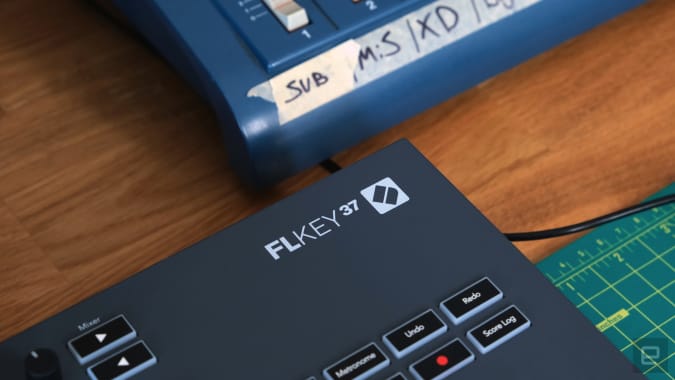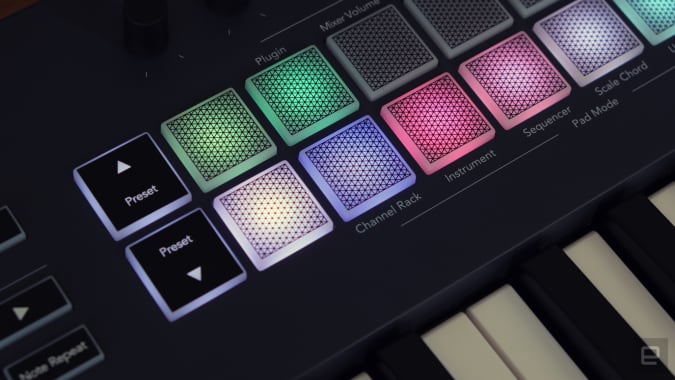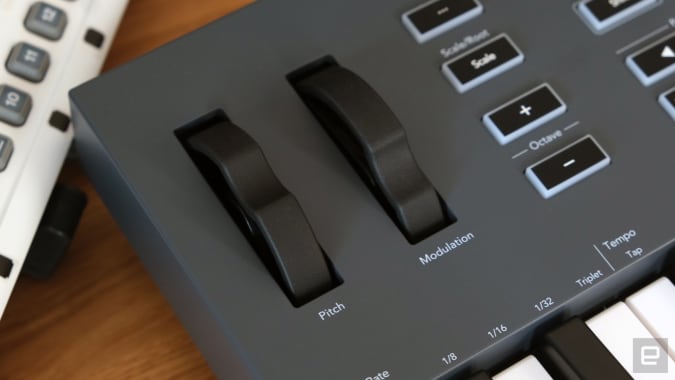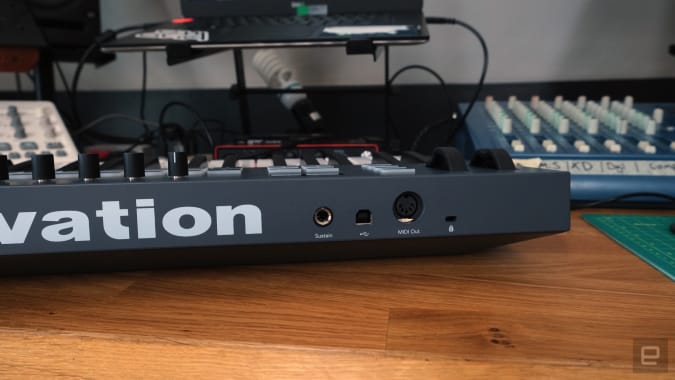It’s hard to believe that (née Fruity Loops) has been around for 24 years. It’s even harder to believe that it took 20 years for someone to make dedicated hardware for the DAW. And that it was another four years before a second company had a stab at it, after . Now Novation is taking its well regarded series, giving it a light facelift and rebranding it as FLKey – the first keyboard MIDI controller designed exclusively for controlling FL Studio.
FLKey comes in two varieties, the FLKey 37 and FLKey Mini. Novation sent over the 37 key version for me to test, and I can tell you that, physically, it’s nearly indistinguishable from the Launchkey 37. It’s got the same full-size keybed, 16 velocity sensitive pads and eight knobs across the top. They even both have the same amount of buttons and pitch and mod wheels placed somewhat awkwardly above the keys. The only real difference is that the FLKeys are gray instead of black, and the labels on the controls are slightly different.

Terrence O’Brien / Engadget
The build is solid, but not what you’d call rugged. I probably wouldn’t take the FLKey out on tour. Everything is plastic, and the keys have a slight springiness to them. The pads are velocity sensitive, and have polyphonic aftertouch, but are a tad stiff and small. They’ll get the job done for finger drumming, but can’t compare with those found on an . There’s a small screen that gives you useful info at a glance, like preset names. And the eight knobs across the top are smooth and have a nice amount of resistance, but are quite small. They make sense on the Mini model, but on the 37 they look slightly out of place. Still, considering the almost rock-bottom price of $200, this is all pretty impressive.
What makes the FLKey stand out, though, is its out-of-the-box mapping for controlling FL Studio. With the pads and pots you can easily control volume and panning both from the mixer and channel rack, control many of Image Line’s native plugins, and play chords with a single button. You can’t ditch the mouse completely, but you can perform most basic tasks directly from the controller.
If you’re intimately familiar with FL Studio, chances are you’ll be able to get further with the keyboard than me. I haven’t used FL Studio much since I was in college and it was still called Fruity Loops. I had to relearn some terminology and try to unlearn some habits I’d developed after years of using Ableton Live as my primary DAW. But once I got over the initial hump, I found it relatively easy getting the rough outline of a track down with just the keyboard.

Terrence O’Brien / Engadget
I actually think that the FLKey lineup offers deeper control than its Ableton-focused siblings in the Launchkey series, at least when it comes to producing a full song from start to finish. Whereas the Launchkey lineup seems more focused on Live’s performance features, FLKey feels built more with production in mind. That probably has as much to do with the difference in the DAWs approaches as anything else, though.
It’s super quick and easy to lock the keyboard into a particular scale, or to assign the pads across the top to the chords in said scale. The latter is especially useful for me since I am what is commonly referred to as a terrible keyboard player. It also takes just a single button push to quantize a performance after you’ve recorded it which, again, is super handy for someone like me who’s simply faking their way around a keyboard.

Terrence O’Brien / Engadget
If you’re sticking to FLStudio’s built-in plugins the knobs are often mapped to controls automatically, though, it seems a little random in terms of what they actually control. This is probably the biggest issue with the FLKey (again, probably more to do with FLStudio’s quirks than anything else) – consistency.
Ableton Live was built very consciously from moment one with UI consistency being high on the list of priorities, so mapping controls is a much simpler and more predictable affair. FLStudio is a bit more hodgepodge. Every plugin has its own unique interface with controls scattered around, and sometimes presented in oddly skeuomorphic ways. In some plugins the mapping is completely nonexistent. For instance, while the buttons for changing presets work flawlessly in DX10 and Harmless, they don’t work at all in Sawyer or GMS. And the mod wheel doesn’t seem to do anything in most plugins.

Terrence O’Brien / Engadget
It’s also worth quickly mentioning that while the back is largely spartan, there is a full-sized 5-pin MIDI DIN there. So, when you’re not knocking out beats with FPC or chopping up samples in SliceX you can control your hardware synths too.
FL Studios quirks can be part of its charm. But it does make it hard to build on top of what Image Line has already done. Still, if there’s any company I’d have faith in making it work, it would be Novation. Over the years it’s developed a reputation for its products and adding new features. So there’s a decent chance that FLKey’s rough edges will get smoothed out.
All products recommended by Engadget are selected by our editorial team, independent of our parent company. Some of our stories include affiliate links. If you buy something through one of these links, we may earn an affiliate commission.
